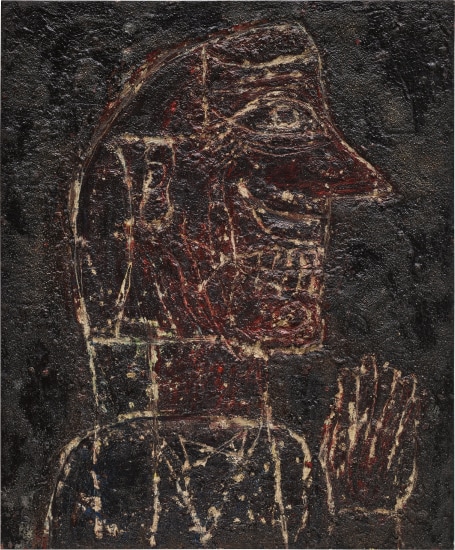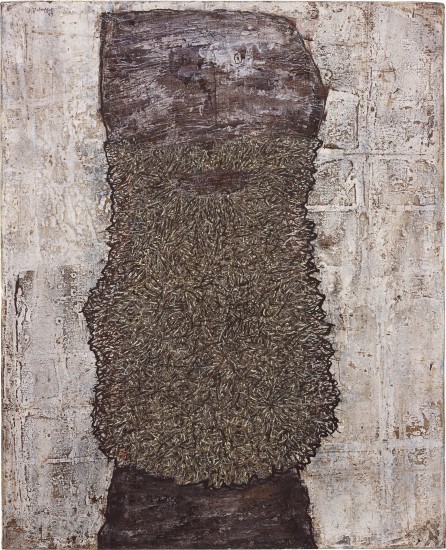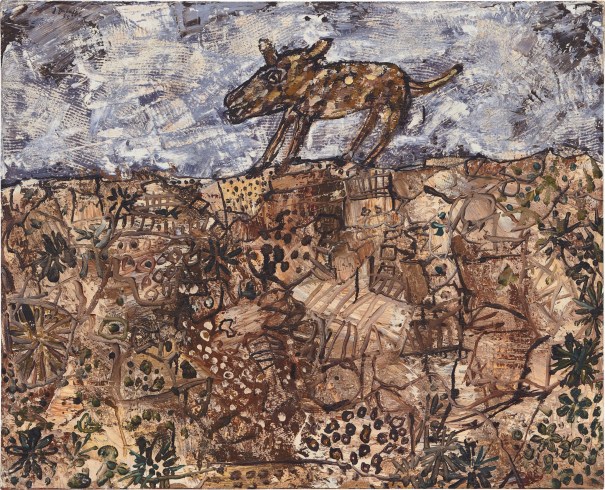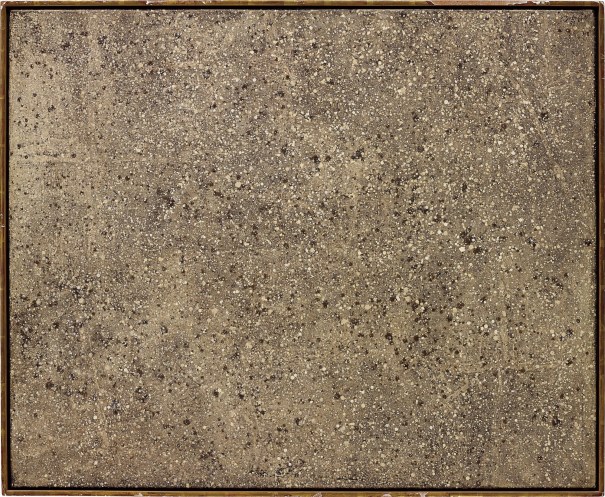Property of a Private Collector, Lisbon Jean Dubuffet Paysage au château (avec 3 personnages) 1975 acrylic on canvas 38 1/4 x 51 1/8 in. (97 x 130 cm) Initialed and dated "J.D. 75" lower right.
Provenance Galerie Beyeler, Basel James Goodman Gallery Inc., New York Waddington Galleries Ltd., London Christie, Manson & Woods, London, Twentieth Century Art Day Sale, December 9, 1999, lot 391 Waddington Galleries, London Acquired from the above by the present owner Exhibited Basel, Galerie Beyeler, J. Dubuffet: parachiffres, mondanités et autres peintures de 1975, May - June, 1976 Literature J. Dubuffet: parachiffres, mondanités et autres peintures de 1975, exh. cat., Galerie Beyeler, Basel, 1976, n.p. Catalogue des Travaux de Jean Dubuffet Fascicule XXX: Parachiffres, Mondanités, Lieux abrégés, Paris: Les Éditions de Minuit, 1982, p. 84, pl. 184 (illustrated) Catalogue Essay Paysage au château (avec 3 personnages) from 1975 is one of Jean Dubuffet’s superb works from the Lieux abrégés series. Throughout his career, Dubuffet frequently borrowed from his earlier series, incorporating various elements as he developed each new style and group within his multifaceted oeuvre. Three individual characters, each depicted singularly, undifferentiated from the background, Paysage au château (avec 3 personnages) builds off of myriad sources from Dubuffet’s own work. Pulling the “agitated linear style of the Bowery Bums…combined with images of people, buildings, cars and buses of the Paris Circus…the cellularity of the Hourloupe…the high color and imagery of his minor key, accompanied by the awkwardness of Art Brut.” (M. Glimcher, Jean Dubuffet Towards an Alternative Reality, Pace Publications, New York, 1987, p.19) Dubuffet imbues his picture with a depth of meaning and continuity. Each individual figure is rendered in strict two-dimensionality; a differentiation of foreground and background is made nearly impossible by the complete lack of perspectival treatment. The figures seem painted as if by a child and in such a way as to immediately and directly address the viewer without any of the intermediary distractions of “realistic” painting. Similarly, the “landscape” has been abstracted into brilliant pastiches of color. Bright pinks, whitened blues, ochre and yellow streaks of paint break up the composition, destroying any ability to relate this scene with any the viewer may have experienced in reality. There is no organized or logical space within the canvas, and as a result the viewer’s eye is forced to rove throughout, piecing together the various elements. In so doing, one becomes increasingly aware of the disjointedness of everyday life and the manner in which his or her senses are constantly bombarded by similarly simultaneous and disjointed stimuli. Much like in the La maison de champagne, 1957, to which he was looking and referencing directly in works such as Paysage au château (avec 3 personnages), Dubuffet has concocted a scene reminiscent and evocative of the natural world but here imbued with a Surrealistic perversion of color and perspective that heightens its immediacy and power. “One must not confuse what the eyes apprehend with what happens when the mind takes it in. In any single instant the eyes see only a side facing them, they converge on a small field. The mind totalizes; it recapitulates all the fields; it makes them dance together. It transforms them too, it reworks them in its own guise…Perhaps we live in a world invented by ourselves…” (J. Dubuffet quoted in M. Glimcher, Jean Dubuffet Towards an Alternative Reality, Pace Publications, New York, 1987, p.19) Dubuffet managed to fashion, in his own particular manner, a new reality built up from the one around him and previously investigated in various forms through his various earlier series. His was an art of the everyday experience simplified and objectified almost to the point of the unknown. The immediacy of everyday experience was something that lay at the heart of Dubuffet’s fascination with art brut - the intuitive, unfettered and instinctive visual languages that Dubuffet had previously sought out in tribal cultures, mental institutions and children
Property of a Private Collector, Lisbon Jean Dubuffet Paysage au château (avec 3 personnages) 1975 acrylic on canvas 38 1/4 x 51 1/8 in. (97 x 130 cm) Initialed and dated "J.D. 75" lower right.
Provenance Galerie Beyeler, Basel James Goodman Gallery Inc., New York Waddington Galleries Ltd., London Christie, Manson & Woods, London, Twentieth Century Art Day Sale, December 9, 1999, lot 391 Waddington Galleries, London Acquired from the above by the present owner Exhibited Basel, Galerie Beyeler, J. Dubuffet: parachiffres, mondanités et autres peintures de 1975, May - June, 1976 Literature J. Dubuffet: parachiffres, mondanités et autres peintures de 1975, exh. cat., Galerie Beyeler, Basel, 1976, n.p. Catalogue des Travaux de Jean Dubuffet Fascicule XXX: Parachiffres, Mondanités, Lieux abrégés, Paris: Les Éditions de Minuit, 1982, p. 84, pl. 184 (illustrated) Catalogue Essay Paysage au château (avec 3 personnages) from 1975 is one of Jean Dubuffet’s superb works from the Lieux abrégés series. Throughout his career, Dubuffet frequently borrowed from his earlier series, incorporating various elements as he developed each new style and group within his multifaceted oeuvre. Three individual characters, each depicted singularly, undifferentiated from the background, Paysage au château (avec 3 personnages) builds off of myriad sources from Dubuffet’s own work. Pulling the “agitated linear style of the Bowery Bums…combined with images of people, buildings, cars and buses of the Paris Circus…the cellularity of the Hourloupe…the high color and imagery of his minor key, accompanied by the awkwardness of Art Brut.” (M. Glimcher, Jean Dubuffet Towards an Alternative Reality, Pace Publications, New York, 1987, p.19) Dubuffet imbues his picture with a depth of meaning and continuity. Each individual figure is rendered in strict two-dimensionality; a differentiation of foreground and background is made nearly impossible by the complete lack of perspectival treatment. The figures seem painted as if by a child and in such a way as to immediately and directly address the viewer without any of the intermediary distractions of “realistic” painting. Similarly, the “landscape” has been abstracted into brilliant pastiches of color. Bright pinks, whitened blues, ochre and yellow streaks of paint break up the composition, destroying any ability to relate this scene with any the viewer may have experienced in reality. There is no organized or logical space within the canvas, and as a result the viewer’s eye is forced to rove throughout, piecing together the various elements. In so doing, one becomes increasingly aware of the disjointedness of everyday life and the manner in which his or her senses are constantly bombarded by similarly simultaneous and disjointed stimuli. Much like in the La maison de champagne, 1957, to which he was looking and referencing directly in works such as Paysage au château (avec 3 personnages), Dubuffet has concocted a scene reminiscent and evocative of the natural world but here imbued with a Surrealistic perversion of color and perspective that heightens its immediacy and power. “One must not confuse what the eyes apprehend with what happens when the mind takes it in. In any single instant the eyes see only a side facing them, they converge on a small field. The mind totalizes; it recapitulates all the fields; it makes them dance together. It transforms them too, it reworks them in its own guise…Perhaps we live in a world invented by ourselves…” (J. Dubuffet quoted in M. Glimcher, Jean Dubuffet Towards an Alternative Reality, Pace Publications, New York, 1987, p.19) Dubuffet managed to fashion, in his own particular manner, a new reality built up from the one around him and previously investigated in various forms through his various earlier series. His was an art of the everyday experience simplified and objectified almost to the point of the unknown. The immediacy of everyday experience was something that lay at the heart of Dubuffet’s fascination with art brut - the intuitive, unfettered and instinctive visual languages that Dubuffet had previously sought out in tribal cultures, mental institutions and children
.jpg)


.jpg)








Try LotSearch and its premium features for 7 days - without any costs!
Be notified automatically about new items in upcoming auctions.
Create an alert